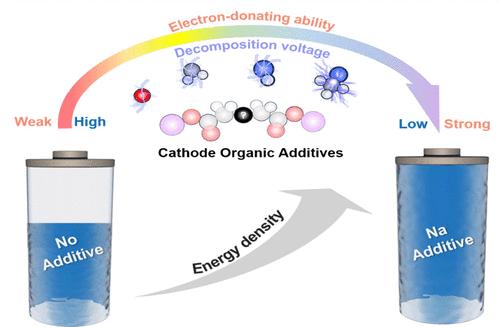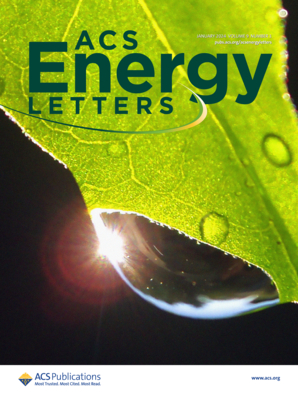电子结构调制实现钠离子电池正极有机添加剂的钠补偿
IF 18.2
1区 材料科学
Q1 CHEMISTRY, PHYSICAL
引用次数: 0
摘要
为了解决由于不可逆的钠离子损失而导致的钠离子电池能量密度降低的问题,阴极钠补偿添加法是目前常用的方法;然而,寻找高效、低电压和低成本的添加剂仍然是一个挑战。本工作开发了一类有机添加剂,即n取代主链C有机化合物。与全c或o取代的有机物相比,N取代的有机物由于N的给电子效应更强,分解电位更低,如果引入其他给电子基团,分解电位会进一步降低。当在P2-Na2/3Ni1/3Mn1/3Ti1/3O2阴极中添加10 wt %的添加剂时,将初始充电容量从96.3 mAh g-1提高到189.4 mAh g-1,并且不会导致循环或倍率性能下降。与硬碳阳极配对的全电池表现出更高的能量密度(150.6 vs 235.1 Wh kg-1),表明这种添加剂具有很大的实际应用潜力。本文章由计算机程序翻译,如有差异,请以英文原文为准。

Electronic Structure Modulation Enables Sodium Compensation in Cathode Organic Additives for Sodium-Ion Batteries
To address the issue of reduced energy density in sodium-ion full cells due to irreversible sodium ion losses, the cathode sodium compensation additive method is the usual approach nowadays; however, finding efficient, low-voltage, and low-cost additives remains a challenge. This work develops a class of organic additives, i.e., N-substituted main-chain C organic compounds. Compared with all-C or O-substituted organics, the N-substituted organics show lower decomposition potentials due to the stronger electron-donating effect of N, and the potentials will be further reduced if other electron-donating groups are introduced. When introduced as an additive into a P2–Na2/3Ni1/3Mn1/3Ti1/3O2 cathode, an addition of 10 wt % enhances the initial charging capacity from 96.3 to 189.4 mAh g–1 and does not cause cycling or rate capability deterioration. The full cells paired with hard carbon anode exhibit higher energy densities (150.6 vs 235.1 Wh kg–1), suggesting that such additives offer great potential for practical applications.
求助全文
通过发布文献求助,成功后即可免费获取论文全文。
去求助
来源期刊

ACS Energy Letters
Energy-Renewable Energy, Sustainability and the Environment
CiteScore
31.20
自引率
5.00%
发文量
469
审稿时长
1 months
期刊介绍:
ACS Energy Letters is a monthly journal that publishes papers reporting new scientific advances in energy research. The journal focuses on topics that are of interest to scientists working in the fundamental and applied sciences. Rapid publication is a central criterion for acceptance, and the journal is known for its quick publication times, with an average of 4-6 weeks from submission to web publication in As Soon As Publishable format.
ACS Energy Letters is ranked as the number one journal in the Web of Science Electrochemistry category. It also ranks within the top 10 journals for Physical Chemistry, Energy & Fuels, and Nanoscience & Nanotechnology.
The journal offers several types of articles, including Letters, Energy Express, Perspectives, Reviews, Editorials, Viewpoints and Energy Focus. Additionally, authors have the option to submit videos that summarize or support the information presented in a Perspective or Review article, which can be highlighted on the journal's website. ACS Energy Letters is abstracted and indexed in Chemical Abstracts Service/SciFinder, EBSCO-summon, PubMed, Web of Science, Scopus and Portico.
 求助内容:
求助内容: 应助结果提醒方式:
应助结果提醒方式:


